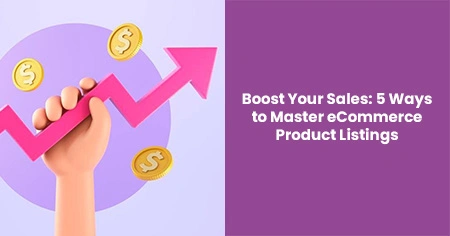The four-column grid displays model images, brand names, descriptions, and prices. Clean, minimalist, and containing only relevant details, the product listing is a seamless design that takes the customer through the buying journey.
To the average person, product listing pages (PLPs) are expected. What makes them exceptional is the ability to convince customers to click the “buy now” button.
Whether you own an online store or sell a service, you should know the importance of a good product listing page. Think of it as your virtual shop window.
Below, we’ll discuss five ways to master eCommerce product listings to boost sales and increase customer engagement.
1. Get the Basics Right
According to Microsoft, about 58% of consumers leave a website without purchasing anything because of a bad experience.
Several factors could contribute to this, including product listing pages, affecting customer engagement and conversation rates. Get the basics right and you can maximize your impact.
Clear Titles
Write clear, descriptive titles highlighting each product’s key features to help customers quickly understand and choose.
SEO Friendliness
Include relevant keywords in product titles to boost search visibility and attract more organic traffic.
Quality Images
Use sharp, high-resolution images to showcase each product on the listing page.
Strong Call To Action (CTA)
Use prominent CTAs like “Buy Now,” “Add to Cart,” or “Learn More.” Position them strategically and make sure they stand out visually.
2. Choose Your Menu
Filter menu options enable hassle-free navigation for your customers. An ideal filter menu filters options to refine searches by attributes, like pricing, color, style, size, etc.
Another alternative is a sorting menu. The sorting menu offers a dropdown with options like “Price: Low to High,” “Newest,” and “Rating: High to Low” for organizing products. This choice is best suited for an online clothing store.
Sorting options are designed to help customers narrow down products and boost conversion. To be effective, they should reflect your audience’s needs and expectations. Understanding your customers' mindset is key to optimizing this stage of the digital journey.
3. Convey Trust
Even the most web-savvy person can fall victim to an online scam. Unfortunately, eCommerce loses billions of dollars annually to fraud.
Exploding Topics explains that 43% of eCommerce consumers have been victims of payment fraud. So forgive their weariness if they think twice before purchasing an item from your store.
Secure payment gateway icons like credit card logos and shield symbols are universally recognized and let customers know their payment information is protected during every transaction, including global payments.
PayPro Global suggests implementing fraud prevention measures by choosing one platform for selling your products. The proactive and tailored integration allows you to scale globally while safeguarding your business with full-cycle fraud defense.
4. Optimize For the User Experience
Many eCommerce stores use bells and whistles to attract online users, but are they practical or just fancy gimmicks?
Don’t fall into the same trap. Optimize your product listing pages for your target audience and the user experience (UX).
Do you know why online stores like Target and ASOS are killing it in eCommerce? Both utilize white space and uncluttered layouts while prominently displaying CTAs without appearing overbearing.
Also, tailor your pages to shoppers with different intentions. What do we mean? Some buyers want to see products that match their specific needs. Others prefer to browse and use product listing pages to explore items that fit their preferences.
5. Product-Led Growth
This will depend on the type of business you own. A product-led growth (PLG) model is typically adopted by SaaS innovators and other software startups.
Viewed as the “Holy Grail” of business models in the software industry, the archetype gives customers control by placing the product at the core of acquisition, retention, and growth.
Companies focussing on digital demand can utilize case-based product demos on product listing pages.
Along with strong SEO-friendly keywords and content, your website can achieve scalable reach that's hard to match with traditional B2B marketing.
Final Say
Revisit your PLP layout and implement the basics like high-quality product images.
Write clear and concise titles. Strategically position your CTAs. Decide which display options you want to filter when choosing your menu.
A trustworthy website and brand retains loyal customers. Ensure your payment gateway is secure and displays universally recognized security icons.
Remember to optimize your PLPs for the user experience. SaaS startups leveraging PLG models can adapt the traditional PLP to accommodate their customers’ needs and wants.








